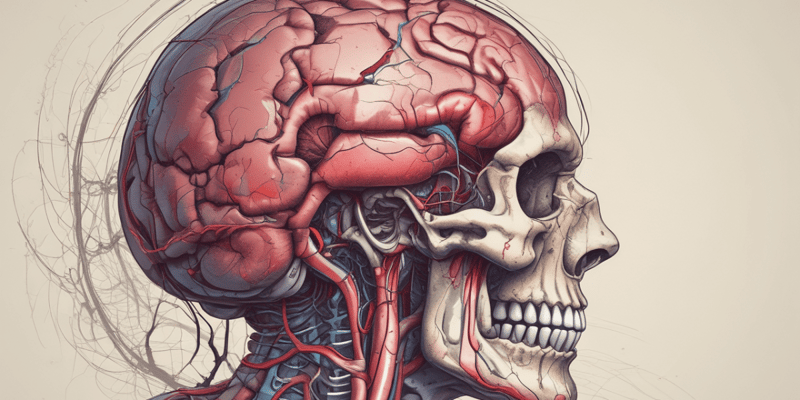Podcast
Questions and Answers
What is the main effect of ischemia on the body?
What is the main effect of ischemia on the body?
Which arteries supplies the primary motor cortex and primary somatosensory cortex?
Which arteries supplies the primary motor cortex and primary somatosensory cortex?
What is the effect of occlusion of the Posterior Cerebral Artery?
What is the effect of occlusion of the Posterior Cerebral Artery?
What is the effect of occlusion of the Basilar Artery?
What is the effect of occlusion of the Basilar Artery?
Signup and view all the answers
What is the effect of occlusion of the Anterior Inferior Cerebellar Artery?
What is the effect of occlusion of the Anterior Inferior Cerebellar Artery?
Signup and view all the answers
What is the effect of occlusion of the Anterior Spinal Artery?
What is the effect of occlusion of the Anterior Spinal Artery?
Signup and view all the answers
What is the effect of occlusion of the Posterior Inferior Cerebellar Artery?
What is the effect of occlusion of the Posterior Inferior Cerebellar Artery?
Signup and view all the answers
What is the most common site for Berry aneurysms?
What is the most common site for Berry aneurysms?
Signup and view all the answers
What is the cause of Berry aneurysms?
What is the cause of Berry aneurysms?
Signup and view all the answers
What is the effect of ruptured Berry aneurysms?
What is the effect of ruptured Berry aneurysms?
Signup and view all the answers
Study Notes
Cerebrovascular Accidents
- Ischemia: decreased oxygen supply to tissues and increased oxygen demand
- Can lead to detrimental effects on the body
Clinical Implications of Vessel Occlusion
Anterior Cerebral Artery
- Supplies primary motor cortex and primary somatosensory cortex
- Occlusion leads to contralateral loss of sensation and motor control in the lower body
Middle Cerebral Artery
- Supplies primary motor cortex and primary somatosensory cortex
- Occlusion leads to contralateral loss of sensation and motor control in the upper body (face and upper limbs)
- Can also lead to Broca's aphasia (inability to produce speech) if Broca's area is damaged
Posterior Cerebral Artery
- Supplies the occipital lobe, which is important for vision
- Occlusion leads to contralateral homonymous hemianopia (loss of visual field)
Basilar Artery
- Occlusion can produce locked-in syndrome, resulting in quadriplegia and preserved vertical eye movements
Anterior Inferior Cerebellar Artery
- Occlusion leads to lateral pontine syndrome
- Can cause facial nerve palsy, vertigo, and hearing loss
- Can also affect the vestibular nuclei, leading to balance and coordination problems
Anterior Spinal Artery
- Occlusion produces medial medullary syndrome
- Can cause hypoglossal nerve palsy, contralateral hemiplegia, and contralateral loss of touch, pressure, and vibration sensations
Posterior Inferior Cerebellar Artery
- Occlusion affects the cerebellum, leading to poor coordination, muscle tone, and balance
- Can also cause vagus nerve palsy, leading to dysphagia and a negative gag reflex
- Can also cause Horner's syndrome (ptosis, miosis, and anhydrosis)
Aneurysms
- Berry aneurysms or saccular aneurysms can occur in the Circle of Willis
- Caused by chronic hypertension or connective tissue disorders
- Can rupture, leading to subarachnoid hemorrhage
- Most common sites:
- Anterior communicating artery (40%)
- Middle cerebral artery (34%)
- Internal carotid artery (20%)
- Vasila artery (4%)
Cerebrovascular Accidents
- Ischemia results in decreased oxygen supply to tissues and increased oxygen demand, leading to detrimental effects on the body
Clinical Implications of Vessel Occlusion
Anterior Cerebral Artery
- Supplies primary motor cortex and primary somatosensory cortex
- Occlusion leads to contralateral loss of sensation and motor control in the lower body
Middle Cerebral Artery
- Supplies primary motor cortex and primary somatosensory cortex
- Occlusion leads to contralateral loss of sensation and motor control in the upper body (face and upper limbs)
- Damage to Broca's area can cause Broca's aphasia (inability to produce speech)
Posterior Cerebral Artery
- Supplies the occipital lobe, essential for vision
- Occlusion leads to contralateral homonymous hemianopia (loss of visual field)
Basilar Artery
- Occlusion can produce locked-in syndrome, resulting in quadriplegia and preserved vertical eye movements
Anterior Inferior Cerebellar Artery
- Occlusion leads to lateral pontine syndrome
- Can cause facial nerve palsy, vertigo, and hearing loss
- Affects the vestibular nuclei, leading to balance and coordination problems
Anterior Spinal Artery
- Occlusion produces medial medullary syndrome
- Can cause hypoglossal nerve palsy, contralateral hemiplegia, and contralateral loss of touch, pressure, and vibration sensations
Posterior Inferior Cerebellar Artery
- Occlusion affects the cerebellum, leading to poor coordination, muscle tone, and balance
- Can cause vagus nerve palsy, leading to dysphagia and a negative gag reflex
- Can also cause Horner's syndrome (ptosis, miosis, and anhydrosis)
Aneurysms
- Berry aneurysms or saccular aneurysms occur in the Circle of Willis
- Caused by chronic hypertension or connective tissue disorders
- Rupture leads to subarachnoid hemorrhage
- Most common sites:
- Anterior communicating artery (40%)
- Middle cerebral artery (34%)
- Internal carotid artery (20%)
- Vasilis artery (4%)
Studying That Suits You
Use AI to generate personalized quizzes and flashcards to suit your learning preferences.
Description
Learn about the clinical implications of vessel occlusion, including the effects of ischemia on the body and the specific consequences of occlusion in the anterior and middle cerebral arteries.




